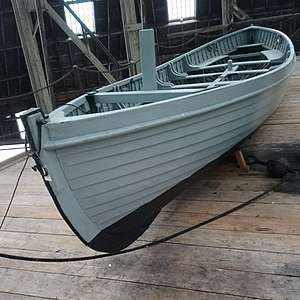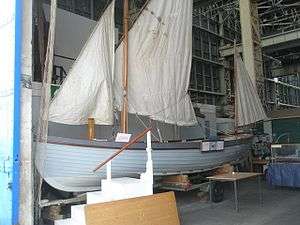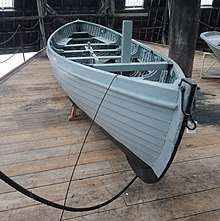Montagu whaler
The Montagu whaler was the standard seaboat of the Royal Navy between 1910- 1970, it was a clinker built 27 by 6 feet (8.2 m × 1.8 m) open boat, which could be pulled by oars or powered by sail. It was double-ended; having a pointed stem and stern. The design of this naval whaler, was proposed by retired Rear Admiral The Honourable Victor Alexander Montagu in 1890 to replace a variety of smaller craft with one single, versatile craft.[1]
 Montagu Whaler within Chatham Dockyard | |
| Class overview | |
|---|---|
| Name: | Montagu 27ft whaler |
| Builders: | Numerous |
| Operators: | |
| In commission: | 1900s–1970s |
| General characteristics | |
| Type: | seaboat |
| Tons burthen: | 2,000–3,000 bm |
| Length: | 27 feet (8.2 m) |
| Beam: | 6 feet (1.8 m) |
| Draught: | 1 foot 5 inches (0.43 m) |
| Sail plan: | gunter rig yawl |
| Complement: | 6 |

They were in use with the Royal Navy - and associated commonwealth navies such as the Royal Australian Navy, Royal New Zealand Navy - until the 1960s. They were used for service, training and recreation, whaler races were organised between ships and ports; minor royalty often handed out the trophies.[2] After service, some were passed on to other groups, including the Sea Cadets.[3]
The whaler was later fitted with outboard motors, and a less successful derivative had an in-board petrol motor. When rowed, it had had four oarsmen and a coxwain; in all it could carry 27 men.[4]
History
The Naval whaler was derived from the commercial whaleboat which were successful sea boats that were launcher from the whaleships in pursuit of whales. These were clinker built craft that were propelled by oars or two sails, a foresail and a mainsail.
The first reference to ‘whaleboats’, was in 1756. They were introduced into Royal Naval service around 1810, when they were called ‘whale-gigs’. They were used to take boarding parties to enemy ships. So that they were unsinkable, they were fitted with buoyancy tanks, They had a secondary role as lifeboats.
During the mid 19th century they were used on in vessels suppressing the slave trade off Africa, in the surf conditions that prevailed in this work. By 1862 they were officially called 'whalers'. [5]
At the turn of the 20th century, retired The Hon. Rear Admiral Victor Alexander Montagu(1841–1915) proposed a few changes to the standard whaler. It was to come in two lengths, 27 ft and 25 ft, and the beam was widened making it more stable. A drop keel was added, which altered the balance so the rig was changed, to mainsail and mizzen. This became known as the Montagu whaler. In this configuration, it continued in service until the 1970s in New Zealand [5]
After 1956 the Montagu was gradually replaced with the 27 foot Motor Whaler, a three-in-one whaler[6] with inboard petrol engine: this could also be pulled or sailed. They were heavy and handled poorly, and were superseded by the Motor Whaler Mod 1. which abandoned the sailing rig.[6] They continued until the 1990s.
Description[7]

The Montagu whaler is a 27 feet (8.2 m) clinker built boat with a generous 6 feet (1.8 m) beam, fitted with a drop keel. In England they were built from wych elm or sand elm. In Malta they used mahogany.[8]
Length: 27 feet (8.2 m)
Beam: 6 feet (1.8 m)
Draught: 1 foot 5 inches (0.43 m)
Weight: (Normal load) 20.5cwt (1020 kg)
Life Saving Capacity: 27
K type rig
This is a yawl rig with a gunter (standing lug) mainsail. The main mast is stepped on the keelson and it is secured by an iron clamp to the second thwart. It is held by a forestay and two shrouds. The mizzen is stepped abaft the stern benches in a shoe on the hog. [8]
Main masts: 16 feet 6 inches (5.0 m)
Mizzen mast: 13 feet (4.0 m)
Yard: 15 feet 3 inches (4.65 m) (gunter)
Boom: 6 feet 10 inches (2.08 m)
K type canvas
Mainsail: 142 square feet (13.2 m2) This is loose footed and laced to the yard which is raised on a traveller on the mainmast. The sheets are rove to the rear thwart. Throat brails are fitted, and used when gybing.[8]
Jib 32 square feet (3.0 m2)
Trisail 68 square feet (6.3 m2)
Mizzen 30 square feet (2.8 m2)
Oars: 4 x 17 feet (5.2 m)
- 1 x 16 feet (4.9 m)
Victor Alexander Montagu
Victor Alexander Montagu's father was the second son of the seventh Earl of Sandwich. His mother, a daughter of the Marquis of Anglesea, who commanded cavalry at Waterloo. His ancestor, the fourth Earl of Sandwich, John Montagu, served as First Lord of the Admiralty and sponsored the voyages of Captain James Cook.
Victor Alexander entered naval college in September 1853 at the age of twelve. In December 1853 he joined HMS Princess Royal, a 91-gun screw-propelled second-rate, as a midshipman junior officer, where he became A.D.C. to his uncle. He was given his first command, his uncle's 12-oared cutter.[6]
He saw active service during the Crimean War, 1854–1856, the 2nd China War where he survived the shipwreck of frigate HMS Raleigh (1845) , and the Indian Mutiny in 1857, Winning five service medals he retired as a Rear Admiral in 1886.[6]
Service Use
Their prime function was to maintain communication with the shore when a vessel was anchored off. The desire to hook up to the shore electricity has caused warships go alongside a jetty, wharf, or quay. The whaler was used to help set or weigh anchor, and fetch water. In addition it was used for training and numerous competitive activities.[1]
This would have a six-man crew:
- Coxswain – Pilots boat and issues command from afore the Mizzen mast.
- Stroke (rearmost)
- Bowman- the lookout (referred to as ‘Bow’)
- No. 2 – stationed near mast
- No. 3 – stationed midships
- No. 4 – stationed before stroke
Preparing the whaler to sail was a co-operative process involving all members of the crew, at the command UP MAST, RIG THE BOAT, the mast had to be set and secured, the centreboard lowered. The sails have to be raised and trimmed.[4]
Pulling races
.jpg)
Leisure Use
When whalers were replaced by rigid inflatables, some were passed down to auxiliary reserves and sea cadet units as training vessels. Others were abandoned and some rescued by enthusiasts, two were seen for many years decaying at Sunderland Point, Lancaster. The Swan took part in the 2019 Great River Race in London, completing the course in 3 hr 15 min 10 sec.[9]
The Swan was a typical Montagu, she was badly burnt then was acquired by Bernie Bruing in the 1960s and towed to Cornwall Beach where she was restored and used for family boat trips. It was sold to Brown of Falmouth and consequently donated to a ferry company but left to rot. Falmouth boat builders recovered her and repaired her so she could be used again, but had no further use for her. Bernie Bruing wrote the folk song ‘The Lament to the Passing of the Montagu Whaler’ [10]
Steve Evans, of the Bristol Charity All Aboard Watersports, came across her while doing internet research, and obtained her for a few pounds and brought her to Bristol to be fully restored at Underfall's yard then to join the All Aboard Watersports fleet.[10]
Glossary [7]
- Apron
- A piece of wood fitted on the inside of the stem, to which the end of the planks are screwed
- Backboard
- A piece of wood across the after end of the stern benches
- Benches
- The seats around the stern sheets
- Bottom Boards
- Pieces of wood joined together, laid on the bottom of the boat as flooring
- Bow
- foremost end of the boat
- Cleats
- pieces of wood or metal secured to the sides of the boat for securing sheets and halliards
- Deadwood
- A piece of wood attached to the keel to strengthen the joint between the keel and the stem and stern
- Garboard Stake
- The first plank laid on the bottom of the boat
- Keel
- The backbone into which the boat is built
- Knees
- Pieces of wood grown to the shape required and used to secure the thwarts to the sides of the boat
- Hog
- A length of wood fitted to the upper part of the keel and extending the length of the keel to the deadwoods, to which the garboard strakes and timbers are secured
- Pulling
- Royal Navy boats were pulled not rowed.[1]
- Risings
- Lengths of wood extending fore and aft over the timbers which support the end of the thwarts
- Seaboats
- Launches, pinnace, cutters, galleys, jollyboats, gigs, whalers and dinghys -boats carried on davits or the deck of a ship [1]
- Stretchers
- Pieces of wood laid across the boat against which rowers place their feet
- Thwarts
- Lateral braces sometimes used as seats across the boat [11]
- Timbers
- Curved pieces of wood which extend outward and upward from the keel and are virtually the ribs of the boat
- Yoke
- A crosshead of wood or metal fitted over the rudder head, to which lines are attached, leading to a tiller for sailing
References
- "British Warships' boats, 1905". www.kiplingsociety.co.uk. Retrieved 17 February 2020.
- "Service vessel; Whaler; Montagu whaler". Small boats. Royal Museums Greenwich. Retrieved 16 February 2020.
- Forster. "Montagu Whaler 536 - lbt". lbt.rforster.org. Retrieved 16 February 2020.
- Reference Guide For Rigging and Sailing the 27 ft Service Whaler (PDF). Canada: Défense nationale. Retrieved 17 February 2020.
- "Naval Whalers". National Museum of the Royal New Zealand Navy. 1 October 2015. Retrieved 15 February 2020.
- "surfresearch". www.surfresearch.com.au. Retrieved 16 February 2020.
- Admiralty Manual of Seamanship, 1922, pp. 277-8.

- Folkard, H C. The Sailing boat. pp. 273–276.
- "The Great River Race Results 2019". www.greatriverrace.co.uk. Retrieved 17 February 2020.
- Yard, Underfall. "The Montagu Whaler". Underfall Yard. Retrieved 17 February 2020.
- McClain, Rick. "Nautical (Sailing) Terms (Words & Phrases), Nomenclature and Illustrations for Sailboating and Sailboarding (Windsurfing)". www.photographers1.com. Retrieved 16 February 2020.
External links
| Wikimedia Commons has media related to Montagu whalers. |